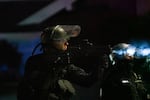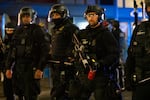Portland police officer testimony in a civil trial last week suggests police in the city have an understanding of civil rights and use-of-force laws that stands in sharp contrast to that of the federal courts and of lawyers for the U.S. Department of Justice. In one instance, an officer appeared to not fully understand the bureau’s use-of-force directives.
Related: Civil trial against Portland starts in 2020 use of force case, dozens to follow
Officers Brent Taylor and Craig Lehman and Det. Erik Kammerer, all members of the now disbanded Rapid Response Team, which was the primary unit policing the 2020 protests, testified last week in a lawsuit brought by Erin Wenzel. The officers who allegedly assaulted Wenzel have not been identified, but Lehman, Taylor and Kammerer were all present the night she was injured. Wenzel alleges officers shoved her to the ground from behind multiple times on Aug. 14, 2020, while she was following their orders to disperse.

In this OPB file photo from 2020, Officer Craig Lehman fires a 40mm less lethal impact munition during racial justice protests at the Penumbra Kelly building in East Portland. Lehman testified in a civil trial on Wednesday last week.
Jonathan Levinson / OPB
Lehman, who briefly took the stand on Wednesday, appeared stumped when asked to explain the bureau’s use of force directives. Wenzel’s attorney John Burgess asked Lehman if he would have been permitted to shove a person to the ground from behind if that person were following officer instructions. Lehman, quoting directly from bureau policies, said it would depend on the totality of the circumstances and the reasonableness of the force.
“What does that mean?” Burgess asked.
“I don’t know how to elaborate more than that,” Lehman responded after a six-second pause, before repeating the directive’s language. “Just the totality of the circumstances, what’s going on and if it was reasonable to do so.”
The police officers who have testified and the attorneys for the city have so far suggested they are free to use force they deem necessary against protesters who are passively resisting and against people in a crowd who they believe may have committed crimes in the past or may commit crimes later in the protest.
Taylor said his experience in past protests and whether or not he knew that someone was a known agitator or that they had been complicit in shield holding or “defending the crowd” all factored into his decision to use force.
Related: Multnomah County DA Mike Schmidt declines charges in 12 cases against Portland police officers
“They feel totally justified using force against people who they deem to be troublemakers based on their physical appearance or past actions,” said Portland attorney Whitney Stark, whose firm represents clients suing the city over alleged violations during 2020 protests. “That’s so wrong. Your job is to protect and serve everybody, including protesters who are protesting you, and you are not doing that.”
Stark said it appeared as though the police had targeted Wenzel and other protesters simply because they were wearing black.
Lehman, Taylor and Kammerer have been at the center of multiple criminal investigations and lawsuits against the city stemming from their use of force during 2020 protests. Taylor was responsible for two use-of-force incidents that led a federal judge to find the city in contempt for violating a temporary restraining order that restricted officers’ use of tear gas and other crowd-control munitions. The three officers have been investigated by the Multnomah County district attorney and the Oregon Department of Justice for possible criminal charges. None have so far been charged with a crime.
The Portland Police Bureau did not respond to a request for comment.

Portland Police Bureau Officer Brent Taylor, right, holds an FN303 less lethal launcher and a can of pepper spray while dispersing a crowd of protesters in a file photo from Aug. 12, 2020, in downtown Portland, Ore. Taylor testified last week in a civil lawsuit against the city over its handling of 2020 protests.
Jonathan Levinson / OPB
Taylor was asked in court if bureau directives would allow him to run full speed at someone who was passively resisting and knock them to the ground.
Referring to a video the jury had just seen showing Taylor shove a protester to the ground from behind, a move identical to what Wenzel said happened to her, Taylor said he couldn’t recall his specific justification for that use of force but he explained that the people in the street were “engaged in criminal conduct.” He added several other factors from earlier in the night which played into his decision to shove the person.
“I know dispersal orders had been given,” Taylor told the jury. “I know … there was violence, there was fires, all kinds of violence towards the police. But her specifically? I don’t know.”
Civil rights lawyers watching the case take issue with Taylor’s understanding of the law.
“It’s passive resistance. They’re not engaging in active conduct,” civil rights attorney Ashlee Albies said of the protesters. “You can’t use force on them to clear them out.”
Passive resistance may include doing things that violate the law, like blocking a public street, but that alone doesn’t justify the use of force, according to the law, she said. Those protesters could be arrested, she said, but unless they resist the arrest, become violent or pose a threat, physical force would not be warranted. Neither Wenzel nor the person in the video played in court was arrested or cited. Blocking the streets during a protest typically does not count as posing a public safety threat justifying force.

The jury room at the Multnomah County Courthouse in downtown Portland, Ore., photographed on Jan. 25, 2021. The county's first civil suit to reach a jury alleging Portland police used excessive violence against a 2020 racial justice protester opened last week.
Courtney Sherwood / OPB
Taylor also testified that he would often push slower protesters lagging towards the back of a crowd even if those protesters were dispersing in the direction police ordered. Taylor said officers believed those protesters were providing cover to others so they could get away from police. In testimony on Thursday and Friday, Taylor’s supervisors corroborated that and said it was their understanding that that is within bureau policy.
“People that are walking slowly as a tactic to delay the line…so that people in the front of the crowd have time to formulate plans, throw projectiles, things like that…We’re going to move those people along at a quicker pace to keep everybody moving,” said Det. Erik Kammerer, Taylor’s squad leader on the Rapid Response Team.
When shown a video of Taylor shoving a protester to the ground from behind during a dispersal, Kammerer agreed it appeared the person was shoved because they were moving slowly.
Related: Oregon won’t charge Portland Det. Kammerer for his role in racial justice protests
Lt. Franz Schoening, the Rapid Response Team commander during the 2020 protests, testified that he never told his officers they could shove slower protesters, but also said he never told them they could not.
Shown two videos appearing to depict slower protesters being shoved by police, Schoening said it’s impossible to say whether or not it was a justified use of force. Schoening said the videos were alarming, but that a lot of things happen that can’t be seen or heard and that there is no obvious reason from the video to think officers violated policy.
Police bureau directives allow the use of force to use force to “accomplish an official purpose.” Bureau leadership testified that that includes clearing the streets after declaring an unlawful assembly. In June 2020, when the use of tear gas was restricted, officers warned they would be forced to physically go into crowds to clear the streets and that tactic was more likely to result in injuries.

Thousands of people in largely peaceful protests in this file photo from May 31, 2020. The protests ended with police using tear gas and rubber bullets to disperse a crowd gathered around the Justice Center in downtown Portland.
Jonathan Levinson / OPB
But the way officers applied force in practice and the testimony from officers and leadership appears to directly contradict the U.S. Department of Justice and a federal judge.
In a June 2020 temporary restraining order restricting the police bureau’s use of tear gas and other impact munitions, District Court Judge Marco Hernandez cited the bureau’s use of force against someone calmly walking and trying to comply with officers’ directions as an example of indiscriminate use of force against peaceful protesters. Hernandez also referred to a woman who told a group of seven Portland police officers she was trying to walk home when the officers rolled tear gas toward her.
Related: Federal judge places formal restrictions on tear gas at Portland protests
“These incidents demonstrate that preventing criminal activity near the Justice Center was not the sole purpose of PPB’s use of force,” Hernandez writes in the order. “Instead, officers may have been substantially motivated by an intent to interfere with Plaintiffs’ constitutionally protected expression.”
More recently, the Justice Department’s 2021 report finding the city out of compliance with the settlement agreement, said Portland police officers conflated active and passive resistance throughout 2020.
“On several occasions, officers justified using force based on asserted physical resistance to members when reports describe only slow walking,” the report states. “Absent pushing back, descriptions of slow walking indicate only passive resistance.”
And in an assessment of the city’s continued noncompliance released this June, the U.S. Department of Justice said the police bureau continues to violate its own use of force directives. The report shed some light on why officers may be confused about the definition of passive resistance.
A DOJ review of Rapid Response Team training materials prompted by an offensive slide that surfaced promoting violence against Marxists and “dirty hippies,” revealed that “the RRT training materials incorrectly portray the legal justification for force.”
The pictures the bureau used to portray active resistance were of a person holding a sign, the Justice Department said. That exact scenario played out in 2020 when Taylor used impact munitions on a protester holding a banner. It was one of the use-of-force incidents that prompted Hernandez to find the city in contempt.
